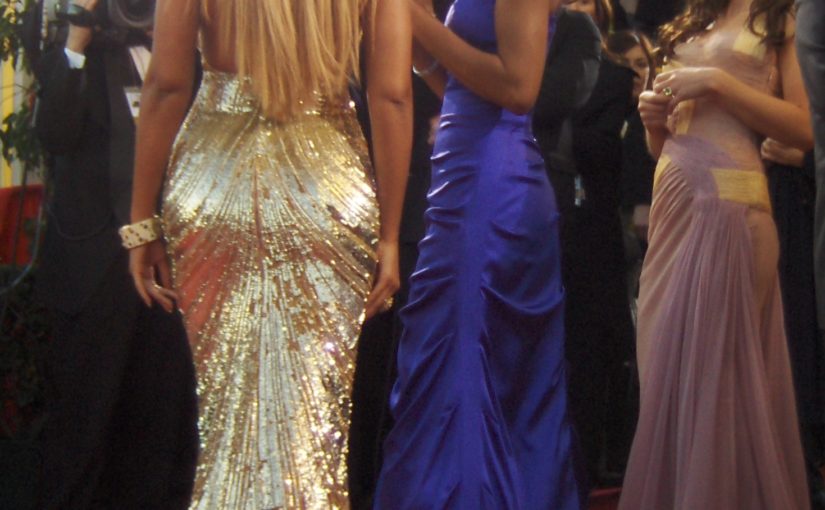You have an important presentation. You have to make a good impression. What do you wear?
I’m not a fashion consultant. My father gave me his fashion sense–I inherited the who-cares-about-the-paint-stains-it’s-still-a-good-shirt gene.
If you took fashion advice from me, you’d definitely “stand out.” I’m even colorblind. I can’t give you specifics about accessories and colors, but fortunately, I don’t need to be a fashion expert to answer the question in principle.
So what do you wear?
What NOT to Wear
 Years ago I began a job that gave me the opportunity to do training in US federal government agencies all over the USA. I was fortunate to get public speaking experience in front of audiences ranging from secret service agents, to smoke jumpers, to pencil pushers.
Years ago I began a job that gave me the opportunity to do training in US federal government agencies all over the USA. I was fortunate to get public speaking experience in front of audiences ranging from secret service agents, to smoke jumpers, to pencil pushers.
My first day training, I wore my best suit!
A few months later I quit wearing the coat.
Months later I wore just nice pants, nice shirt, and tie.
Months later I downgraded to cotton pants.
Months later I lost the tie …
… and kept it that way for the next 5 years.
It wasn’t just because I was uncomfortable. People actually liked me better, learned more, and gave me better evaluations when I DIDN’T wear the tie.
Something about the pretense of your “best” is just a pretense. Decades ago, this blog post would not have been the same, because US culture was different. But in 2017, at least in US culture, pretense is out, and “dressing for success” doesn’t mean what it used to.
Back when I still wore the tie, I happened to be at a US department of agriculture facility in the middle of the New Mexico desert.
Just in case you’ve never worked for the US government, outside, in the sun, all year long, in the middle of the New Mexico desert, let me assure you: They don’t wear three-piece suits to work!
At the end of my seminar, I joked that because of my tie I was overdressed. The next thing I know, a man in the front row, opened up to me about how often “city-slickers” show up in their suits to give official presentations. According to this US government employee, guess what happens after the presenter leaves? They make fun of the guy in the suit!
Why? Because when you show up in a three-piece suit (or a little black dress) in the middle of the desert to talk to a bunch of people wearing blue jeans, everybody in the audience is feeling the same thing:
You’re not one of us!
By over-dressing (or under-dressing), you’re unintentionally sending the message that you are not part of the group. That unintentionally makes you less interesting and less persuasive.
The same thing happens when you’re the only one in a dress, or the only one in jeans, or the only one in shorts, the only one in a tee-shirt, the only one in makeup, etc.
What to wear?
So what do you wear? Easy:
Start with the same thing as everyone else.
The answer of what to wear is not about fashion. If you want to be an effective communicator, you don’t have to look the best, you just have to look normal.
Depending on to whom you are speaking, normal may be anything: a tux, a dress, blue jeans, boots, high heels, or anything else.
I’ve heard WAY too many people promote the myth that you should always dress for success. Technically, that’s true. You should dress for success, but dressing for success does not always mean dressing your BEST!
 Why was a black turtleneck and jeans good enough for Steve Jobs? Because it was normal!
Why was a black turtleneck and jeans good enough for Steve Jobs? Because it was normal!
If your best does not fit in with the audiences version of “normal” you are breaking rapport with your audience. In that case, dressing your best will actually do you a disservice.
Standing on stage and talking about your imported designer shoes will give the wrong impression if your audience isn’t made up of the kind of people who also wear imported designer shoes. I’ve seen this happen. The audience politely ignores the shoes, and the speaker obliviously ignores the lack of rapport.
You must dress nice enough that they notice–so they know you care–but not extreme enough to be a distraction.
It’s true that scientific studies have shown that better looking, better dressed people can appear more trustworthy, more confident, more credible and smarter. In isolation, yes.
But in a public speaking or presentation situation, rapport is the more important goal. No amount of IQ points or trustworthiness will overcome a lack of rapport, and to build rapport you must mirror the audience. Mirror their words, mirror their attitudes, mirror their body language, and yes–mirror their attire.
Public Speaking Attire Rules
You can’t answer the question what to wear unless you know the audience. My rule of thumb is this:
Dress slightly nicer than the audience.
First, I have to know what the audience will wear. I mirror their attire in some way, so that I appear “normal.” That builds rapport. Whenever I’m hired to give a keynote or a seminar, one of the questions on my checklist is to ask the host what people in his or her organization will wear.
Second, I want the advantage that science tells me better dressed people achieve, so I take my wardrobe up just one notch–not all the way up–just enough that they know I’m supposed to be the center of attention, but not enough to break rapport.
Yes, there are exceptions. Just remember that the exceptions are always based not on what YOU think is appropriate, but based on what the AUDIENCE thinks is appropriate:
Nice and noticeable, but normal.
Don’t wear a three piece suit in a room full of agricultural field researchers.
Don’t wear a bathing suit to an awards ceremony.
Do dress for success.
Dress slightly nicer than the audience.
That’s how you’ll succeed.
Beyonce and Evangeline Lilly image source: http://commons.wikimedia.org/wiki/File:Beyonce_and_Evangeline_Lilly.jpg






